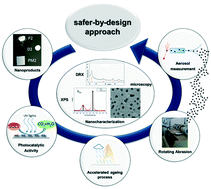Characterization of photocatalytic paints: a relationship between the photocatalytic properties – release of nanoparticles and volatile organic compounds†‡
Abstract
Photocatalytic TiO2 appears to be a promising material to eliminate many air pollutants such as nitrogen oxides (NOx) and volatile organic compounds (VOCs). However, a number of questions remain unanswered prior to its full optimization. Some photocatalytic materials are already commercialized but their photocatalytic effects are questionable. In the present study, characterization of two paints for indoor and outdoor applications, one containing micro-sized titanium dioxide (TiO2) particles and the other based on nano-TiO2, is undertaken in order to understand their environmental impact during the use phase. The photocatalytic efficiency of the paints is determined before and after climatic ageing. The degradation of the paints induced by their ageing is characterized in parallel. Powders, dispersions and paints applied on a substrate are investigated to characterize the state of the nanoparticles (NPs) as a function of their surrounding media. The abrasion of the photocatalytic materials indicates that the presence of TiO2 (NPs) enhances the organic matrix degradation of the paints due to a greater photocatalytic effect. The online and continuous measurements by PTR-ToF-MS indicate that the degradation of the organic matrix leads to release of organic compounds (formaldehyde, methanol, acetaldehyde and formic acid) into the air which suggests that monitoring only the removal of VOCs (in this case xylene) is not enough to make a proper evaluation of the effectiveness of photocatalytic paints towards VOC elimination. These VOCs emerge exclusively from the degradation of the organic matrix as much lower VOC emissions were measured in the case of the aged paint which exhibits a lower amount of organic components in the matrix. This study links the morphological observations, chemical determination, structural parameters and photocatalytic properties of the paints for future optimization of safer-by-design photocatalytic paints.



 Please wait while we load your content...
Please wait while we load your content...